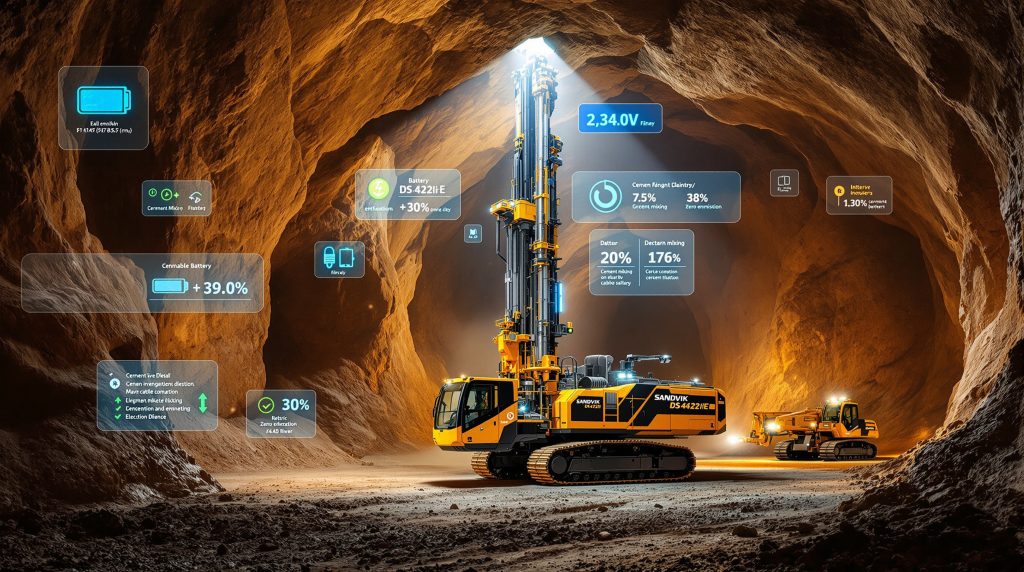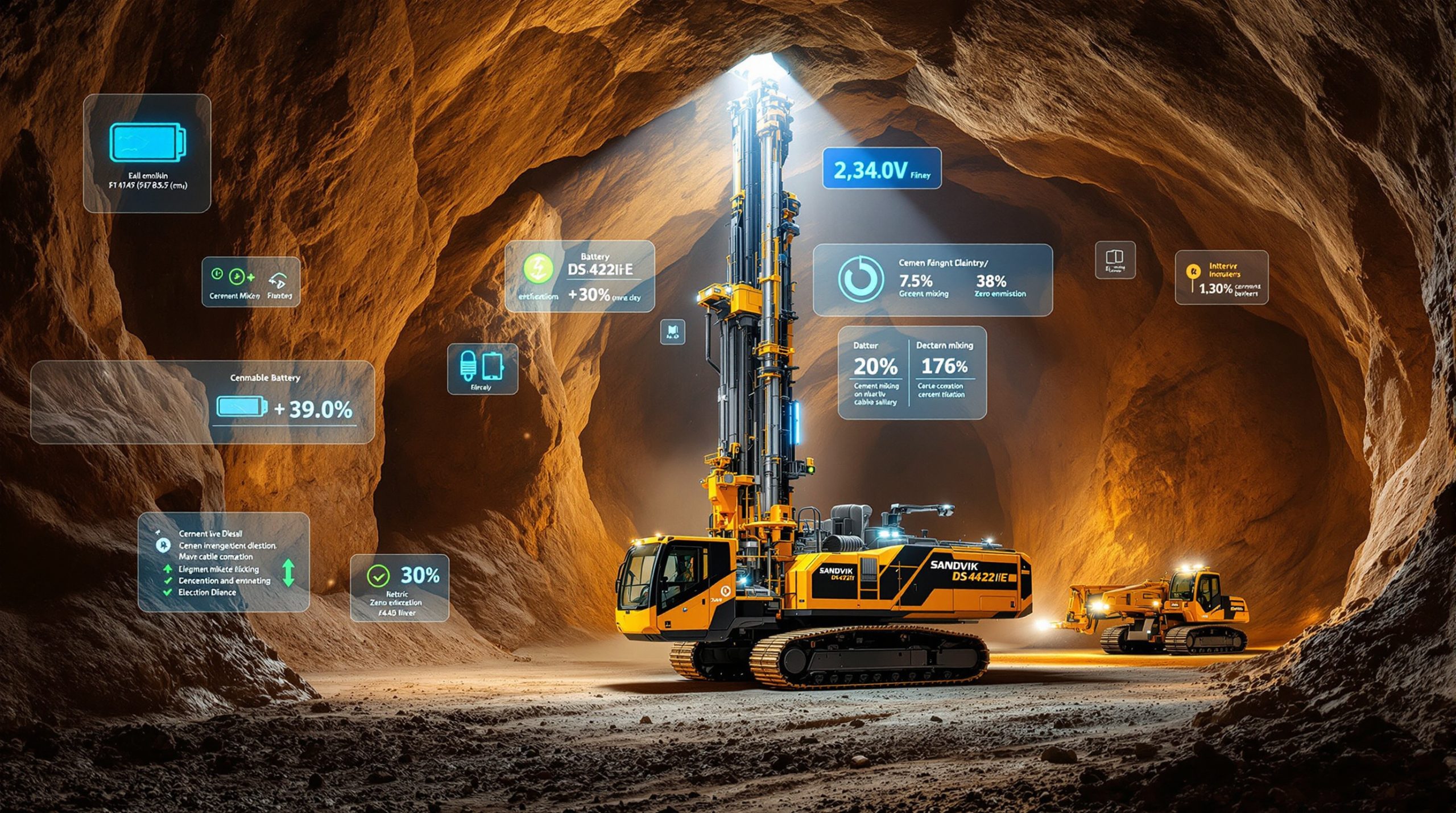Zero-Emission Operations Transform Underground Air Quality
Battery-electric cable bolting eliminates diesel exhaust at the point of operation, removing particulate matter, nitrogen oxides, and carbon monoxide from underground work areas. Traditional diesel equipment produces approximately 2.6 kilograms of CO2 per litre of fuel consumed, alongside harmful pollutants that accumulate in poorly ventilated underground spaces.
The Sandvik battery-powered cable bolter DS422iE represents the first commercially available solution designed specifically for cement-grouted cable bolt installation without diesel emissions. This equipment targets underground mines and tunnel construction projects where air quality regulations increasingly restrict diesel equipment operation. Furthermore, the mining industry evolution towards cleaner technologies emphasises the importance of such innovations.
Elimination of diesel exhaust reduces ventilation requirements in underground workings. Mining operations typically design ventilation systems to manage diesel emissions, requiring substantial air movement through underground areas. Battery-electric equipment reduces this ventilation load, potentially lowering energy consumption for mine-wide air circulation systems.
Lithium-Iron Phosphate Battery Technology Integration
The DS422iE utilises lithium-iron phosphate (LFP) battery chemistry, selected for thermal stability and extended cycle life in industrial applications. LFP batteries demonstrate operational safety advantages over other lithium chemistries, with thermal runaway temperatures exceeding 200°C compared to approximately 150°C for lithium-ion alternatives.
Key LFP characteristics for mining equipment applications include:
• Energy density of 100-160 Wh/kg enabling compact battery pack design
• Cycle life exceeding 3,000 charge-discharge cycles before degrading to 80% capacity
• Nominal cell voltage of 3.2V providing system design flexibility
• Superior performance in temperature extremes common in underground environments
• Reduced fire hazard compared to other lithium battery chemistries
Battery management systems in modern mining equipment monitor individual cell voltage, temperature, and state of charge to optimise performance and prevent damage. These systems enable predictive maintenance by tracking battery health degradation patterns over operational cycles. Additionally, AI in drilling technologies are increasingly integrated with such systems to enhance operational efficiency.
Operational Independence from Continuous Grid Connection
Battery-electric equipment provides operational flexibility in areas with limited electrical infrastructure access. The DS422iE claims operational periods exceeding four hours without grid connection, enabling work in remote underground locations or areas where electrical distribution infrastructure remains incomplete.
This operational independence differs from traditional diesel dependency on fuel transport logistics. Underground fuel handling requires specialised safety protocols, storage infrastructure, and regular resupply operations. Battery systems eliminate fuel transportation risks while enabling charging from renewable energy sources at surface facilities.
Charging infrastructure requirements vary based on available power capacity and operational schedules. Rapid charging capabilities require higher-capacity electrical connections, whilst slower overnight charging can utilise standard industrial power supplies. Mine planners must evaluate charging infrastructure investment against operational flexibility benefits.
Performance Specifications Versus Diesel-Powered Systems
The transition from diesel to battery-electric cable bolting involves performance trade-offs requiring careful evaluation. Diesel systems provide extended operational periods limited primarily by fuel tank capacity, whilst battery systems offer different operational characteristics with unique advantages and constraints. However, decarbonisation in mining initiatives are driving these technological shifts across the industry.
| Performance Factor | Battery-Electric DS422iE | Diesel Cable Bolter |
|---|---|---|
| Operational Duration | 4+ hours continuous | 8-12 hours typical |
| Refuelling/Recharge Time | Variable (2-6 hours) | 15-30 minutes |
| Noise Level | Significantly reduced | 85-95 dB(A) typical |
| Emissions at Point of Use | Zero | CO2, NOx, particulates |
| Torque Delivery | Instant maximum torque | RPM-dependent torque curve |
| Maintenance Intervals | Extended intervals | Frequent engine service |
Electric motor systems deliver maximum torque instantly from zero RPM, providing advantages for drilling applications requiring precise control. Diesel engines require combustion timing coordination and RPM buildup to achieve peak torque output, potentially affecting drilling precision in challenging ground conditions.
Power Output and Drilling Performance Analysis
Electric drive systems enable precise speed and torque control through electronic feedback mechanisms. Variable frequency drives allow infinitely adjustable drilling parameters within motor specifications, improving control compared to hydraulic systems dependent on engine RPM and pump displacement.
The DS422iE accommodates cable bolts up to 25 metres in length, supporting deep reinforcement applications in large-span underground excavations. This capacity addresses requirements for longwall mining, large chamber mining, and deep infrastructure tunnel construction where extended anchor lengths provide superior ground control.
Modern cable bolting requires drilling precision to maintain hole alignment over extended lengths. Deviation in long holes can prevent proper cable installation or reduce anchor effectiveness. Electric motor control systems provide consistent rotational speed and feed rate compared to hydraulic systems experiencing pressure fluctuations from diesel engine RPM variations.
Economic Comparison Over Equipment Lifecycle
Operating cost analysis must consider multiple factors beyond simple fuel versus electricity pricing. Battery-electric systems typically demonstrate advantages in:
Energy Costs:
• Electricity pricing typically 60-80% lower than diesel per unit energy output
• Potential for renewable energy integration at mine sites
• Reduced price volatility compared to diesel fuel markets
Maintenance Cost Reduction:
• Elimination of engine oil changes, filter replacements, and combustion system maintenance
• Reduced hydraulic system complexity in some configurations
• Extended service intervals for mechanical components
Productivity Factors:
• Reduced downtime for refuelling operations
• Improved precision potentially reducing installation rework
• Enhanced operator comfort in emission-free environment
However, battery replacement costs must be factored into long-term economic projections. LFP batteries typically require replacement after 5-8 years of intensive use, representing a significant capital expense requiring budgetary planning.
Technical Specifications Driving Underground Productivity
The DS422iE incorporates automated cement mixing capabilities through an integrated 600-kilogram silo system. This capacity supports approximately 4-6 cable bolt installations depending on hole length and grouting requirements, reducing material handling and setup time between installations.
Automated mixing systems improve grout consistency compared to manual preparation methods. Consistent water-to-cement ratios and mixing duration reduce variability in grout properties, potentially improving cable bolt performance and reducing installation failures requiring remedial work. Consequently, data-driven mining ops are becoming crucial for optimising such automated systems.
Advanced Cabin Design and Operator Interface
The DS422iE features cabin design improvements claimed to provide 55% better visibility compared to previous models. Enhanced visibility reduces operator fatigue and improves drilling accuracy, particularly important for long-hole applications requiring precise alignment.
Modern cable bolting operations integrate digital control systems monitoring drilling parameters in real-time. These systems track:
• Drilling speed and penetration rate
• Torque and thrust force application
• Hole depth and angular alignment
• Grout mixing parameters and injection pressure
• Battery status and remaining operational time
Digital integration enables data collection for productivity analysis and equipment optimisation. Historical drilling data helps operators identify optimal parameters for different ground conditions and improve installation consistency.
Battery Management and Charging Infrastructure
Sophisticated battery management systems protect against overcharging, over-discharge, and thermal damage whilst maximising operational efficiency. These systems balance individual cell voltages during charging cycles and monitor degradation patterns to predict maintenance requirements.
Charging infrastructure planning requires coordination with mine electrical systems. High-capacity charging demands significant electrical load, potentially requiring dedicated transformers and distribution circuits. Mine operators must evaluate charging infrastructure investment against operational benefits and scheduling flexibility.
Alternative charging approaches include mobile charging units, enabling battery equipment operation in areas without permanent electrical infrastructure. These systems provide operational flexibility at the cost of additional equipment complexity and logistics coordination.
Applications in Modern Underground Mining Operations
Battery-electric cable bolting systems address specific challenges in underground mining environments where traditional diesel equipment faces operational limitations or regulatory restrictions. These applications span multiple mining sectors with varying technical requirements. Furthermore, electric mining transportation is complementing these advancements.
Underground Mines with Ventilation Constraints
Deep underground operations often struggle with ventilation capacity limitations, particularly in older mines where ventilation infrastructure was designed for smaller-scale operations. Adding diesel equipment to these environments requires proportional increases in ventilation capacity, representing significant capital investment.
The Sandvik battery-powered cable bolter eliminates the need for additional ventilation capacity to manage diesel emissions. This advantage proves particularly valuable in:
• Deep metalliferous mines below 500 metres depth
• Underground coal operations with methane management requirements
• Urban tunnel construction with strict emission regulations
• Mining operations in environmentally sensitive areas
Operations with Electrical Grid Limitations
Remote mining operations often face electrical supply reliability challenges affecting underground equipment operation. Battery systems provide operational continuity during grid interruptions whilst enabling work scheduling independent of electrical supply constraints.
Mining operations in developing regions may experience frequent power outages or voltage instability affecting electrically-powered equipment. Battery-electric systems with robust charging capabilities can maintain productivity during grid disruptions whilst providing power quality isolation for sensitive electronic components.
ESG-Focused Mining Companies
Environmental, social, and governance (ESG) considerations increasingly influence mining equipment selection decisions. Battery-electric equipment supports ESG objectives through:
• Direct emission reduction at operational sites
• Potential for renewable energy integration
• Improved underground air quality for worker health
• Alignment with corporate sustainability commitments
• Enhanced regulatory compliance in emission-restricted areas
Mining companies facing investor pressure to demonstrate environmental progress often prioritise equipment purchases supporting measurable emission reductions. Battery-electric cable bolting provides quantifiable environmental benefits compared to diesel alternatives.
Digital Integration and Remote Monitoring Capabilities
Modern mining operations increasingly rely on digital systems for equipment monitoring, productivity optimisation, and predictive maintenance. Battery-electric systems naturally integrate with digital infrastructure through electronic control systems and data collection capabilities.
The DS422iE incorporates integration with Sandvik's iSURE platform for real-time equipment monitoring and analytics. This system tracks operational parameters, maintenance requirements, and productivity metrics across fleet operations.
Real-Time Performance Analytics
Digital monitoring systems collect comprehensive operational data including:
• Drilling parameters (speed, torque, thrust, penetration rate)
• Battery performance (state of charge, temperature, charging cycles)
• Grout mixing and injection data
• Equipment utilisation and idle time
• Maintenance alerts and service intervals
This data enables optimisation of drilling parameters for different ground conditions and identification of inefficient operational practices. Fleet managers can compare operator performance and equipment utilisation across multiple units.
Predictive Maintenance Through Data Analytics
Continuous monitoring enables predictive maintenance approaches reducing unplanned downtime. Battery management systems track degradation patterns predicting replacement requirements, whilst mechanical system monitoring identifies wear patterns before component failure.
Predictive maintenance provides cost advantages through:
• Reduced emergency repair costs
• Optimised parts inventory management
• Scheduled maintenance during planned downtime
• Extended equipment lifecycle through proper maintenance timing
Remote diagnostic capabilities enable technical support personnel to troubleshoot issues without immediate site access, reducing downtime and service costs for remote mining operations.
Economic Investment Analysis for Mining Operations
The transition to battery-electric cable bolting requires comprehensive financial analysis considering capital costs, operational savings, and productivity improvements. Initial equipment costs typically exceed diesel alternatives, requiring justification through operational benefits and lifecycle cost analysis.
Capital Expenditure Considerations
Battery-electric equipment generally requires higher initial capital investment compared to diesel alternatives. This premium reflects:
• Advanced battery systems and management electronics
• Electric motor and control system complexity
• Digital integration and monitoring capabilities
• Lower production volumes during early market adoption
However, purchase price comparisons must consider total cost of ownership over equipment lifecycle. Operating cost reductions and productivity improvements may justify higher initial investment depending on operational conditions and utilisation patterns.
Operational Cost Reduction Opportunities
Battery-electric systems provide operational cost advantages through multiple mechanisms:
Energy Cost Savings:
• Electricity typically costs 60-80% less than diesel fuel per unit energy output
• Potential for renewable energy integration reducing grid electricity costs
• Price stability compared to volatile diesel fuel markets
Maintenance Cost Reduction:
• Elimination of engine maintenance (oil changes, filters, injectors)
• Reduced hydraulic system complexity
• Extended service intervals for mechanical components
• Simplified diagnostic procedures through digital monitoring
Productivity Improvements:
• Reduced refuelling downtime compared to diesel systems
• Improved drilling precision reducing rework requirements
• Enhanced operator comfort and safety in emission-free environment
Return on Investment Timeline Analysis
ROI calculations depend heavily on operational intensity and local cost structures. High-utilisation operations typically achieve faster payback through maximised operational savings, whilst low-utilisation applications may require extended payback periods.
| Utilisation Level | Annual Operating Hours | Typical ROI Period |
|---|---|---|
| High Utilisation | 4,000+ hours | 3-5 years |
| Moderate Utilisation | 2,000-4,000 hours | 5-7 years |
| Low Utilisation | <2,000 hours | 7+ years |
These estimates require validation against specific operational conditions, local energy costs, and productivity improvement factors unique to each mining operation.
Safety Improvements Through Electrification
Battery-electric cable bolting systems deliver measurable safety improvements compared to diesel alternatives, addressing multiple risk factors in underground mining environments.
Elimination of Combustion-Related Hazards
Diesel equipment introduces fire and explosion risks through fuel storage, combustion processes, and hot exhaust systems. Battery-electric systems eliminate these hazards whilst providing operational benefits:
• No diesel fuel storage or handling requirements underground
• Elimination of hot exhaust surfaces that could ignite methane or other gases
• Reduced fire load in underground areas
• No combustion-related carbon monoxide production
Underground mining operations must manage multiple ignition sources including electrical equipment, mechanical friction, and combustion engines. Eliminating diesel combustion reduces overall fire and explosion risk in potentially hazardous atmospheres.
Enhanced Air Quality for Worker Health
Diesel exhaust exposure has been linked to respiratory health issues and increased cancer risk according to occupational health studies. Battery-electric equipment eliminates this exposure source, providing immediate health benefits for underground workers.
Improved air quality reduces requirements for personal protective equipment related to diesel exhaust exposure. Workers report improved comfort and reduced fatigue in emission-free environments, potentially improving productivity and job satisfaction.
Operational Safety Through Improved Visibility
The DS422iE cabin design improvements provide enhanced operator visibility reducing accident risk during drilling and positioning operations. Better visibility enables:
• More accurate equipment positioning reducing struck-by hazards
• Improved awareness of underground personnel and equipment
• Enhanced precision in drilling operations reducing ground control failures
• Better monitoring of cable installation procedures
Reduced noise levels from electric motors improve communication in underground work areas, enabling better coordination between operators and ground personnel during cable bolting operations.
Future Implications for Underground Mining Equipment
The introduction of battery-electric cable bolting represents broader industry trends toward underground equipment electrification. This transition reflects multiple driving forces including environmental regulations, technological advancement, and economic optimisation opportunities.
Industry Adoption Timeline and Market Evolution
Mining equipment electrification follows a predictable adoption pattern beginning with smaller, specialised equipment before progressing to larger production machines. Cable bolting systems represent an intermediate step in this evolution, demonstrating technology maturity whilst addressing specific operational challenges.
Early adopters typically include:
• Mining operations in environmentally regulated jurisdictions
• Companies with aggressive ESG commitments
• Operations experiencing ventilation capacity constraints
• Mines seeking operational cost optimisation
Market penetration will likely accelerate as battery technology improves and equipment costs decline through increased production volumes. Industry analysts project significant growth in battery-electric mining equipment adoption over the next decade.
Technology Development Trajectory
Continued advancement in battery technology will address current limitations of electric mining equipment:
Battery Energy Density Improvements:
• Next-generation battery chemistries promising higher energy density
• Solid-state batteries potentially offering superior performance characteristics
• Advanced thermal management enabling operation in extreme conditions
Charging Infrastructure Evolution:
• Ultra-fast charging systems reducing charging time requirements
• Wireless charging technology eliminating cable connections
• Battery swapping systems enabling continuous operation
System Integration Advancement:
• Improved integration with mine automation systems
• Enhanced predictive maintenance capabilities through machine learning
• Advanced control systems optimising performance for specific applications
Competitive Technology Analysis
Alternative technologies compete with battery-electric systems for underground mining applications:
Hybrid Systems:
• Combination of battery and diesel power for extended range
• Complexity trade-offs versus pure electric or diesel systems
• Potential transitional technology for specific applications
Fuel Cell Technology:
• Hydrogen fuel cells offering rapid refuelling and extended range
• Infrastructure requirements and cost considerations
• Safety considerations for hydrogen storage and handling
Advanced Diesel Systems:
• Tier 4 diesel engines with advanced emission control
• Biofuel compatibility for reduced carbon footprint
• Continued improvement in fuel efficiency and emission reduction
The Sandvik battery-powered cable bolter represents current state-of-the-art technology, though future developments may offer superior performance characteristics or cost advantages requiring ongoing technology evaluation.
Implementation Challenges and Operational Considerations
Successful deployment of battery-electric cable bolting systems requires careful planning and consideration of operational constraints that may limit effectiveness or require additional investment.
Charging Infrastructure Development Requirements
Battery-electric equipment demands robust electrical infrastructure capable of supporting high-power charging requirements. Underground mining operations may require significant electrical system upgrades:
Power Distribution Upgrades:
• Increased transformer capacity for charging loads
• Underground electrical distribution system expansion
• Dedicated charging circuits with appropriate protection systems
• Integration with existing mine power systems
Charging Station Installation:
• Strategic placement for operational efficiency
• Environmental protection for underground conditions
• Safety systems for electrical isolation and emergency procedures
• Integration with equipment scheduling and fleet management
Charging infrastructure investment can represent substantial capital requirements, particularly for operations upgrading from minimal electrical infrastructure. Cost-benefit analysis must include infrastructure development costs alongside equipment purchase prices.
Battery Lifecycle Management and Replacement Planning
LFP batteries require systematic lifecycle management to optimise performance and minimise total cost of ownership. Battery degradation affects operational capacity and requires proactive replacement planning:
Performance Monitoring:
• Continuous tracking of battery health and capacity degradation
• Predictive modelling for replacement timing optimisation
• Integration with maintenance planning and budgeting processes
Replacement Cost Planning:
• Battery replacement represents significant expense (typically 25-40% of initial equipment cost)
• Scheduling replacement to minimise operational disruption
• Battery recycling and disposal considerations
Second-Life Applications:
• Retired mining equipment batteries may retain sufficient capacity for stationary applications
• Energy storage for mine site renewable energy systems
• Revenue generation through battery second-life utilisation
Training and Skill Development Requirements
Battery-electric equipment requires different maintenance and operational skills compared to traditional diesel systems. Mining operations must invest in personnel development:
Operator Training:
• Battery system operation and safety procedures
• Charging protocols and best practices
• Digital system operation and monitoring
• Emergency procedures specific to electric equipment
Maintenance Personnel Development:
• Electrical system troubleshooting and repair
• Battery system maintenance and safety procedures
• High-voltage safety training and certification
• Digital diagnostic system operation
Training requirements may necessitate external education programmes or consultant support during implementation phases, representing additional implementation costs requiring budgetary consideration.
Strategic Implementation for Modern Mining Operations
The DS422iE battery-electric cable bolter represents a strategic technology investment addressing multiple operational challenges whilst positioning mining operations for regulatory compliance and competitive advantage.
Environmental Compliance and Regulatory Positioning
Increasingly stringent environmental regulations drive mining operations toward equipment electrification. The Sandvik battery-powered cable bolter provides measurable emission reductions supporting regulatory compliance and environmental reporting requirements.
Proactive adoption of emission-reducing technologies positions mining operations advantageously for future regulatory developments. Regulatory trends consistently favour increased emission controls and renewable energy adoption, making early electrification investment strategically prudent.
Integration with Comprehensive Electrification Strategies
Cable bolting electrification represents one component of broader mine electrification strategies encompassing multiple equipment categories. Coordinated electrification planning optimises infrastructure investment and operational benefits:
• Underground transportation systems (electric vehicles, conveyors)
• Drilling and blasting equipment electrification
• Materials handling system optimisation
• Renewable energy integration at mine sites
Systematic electrification planning enables economies of scale in infrastructure development whilst maximising operational and environmental benefits across equipment categories.
Long-term Competitive Advantages
Early adoption of advanced battery-electric equipment provides competitive advantages through operational efficiency improvements, cost reduction, and enhanced regulatory positioning. These advantages compound over time as technology matures and costs decline.
Mining operations investing in electrification technology development position themselves advantageously for future equipment purchases, operational optimisation, and potential carbon trading opportunities as carbon markets develop.
The transition to battery-electric underground equipment represents a fundamental shift in mining operations, with cable bolting systems serving as an important stepping stone toward comprehensive electrification of underground mining activities.
Looking to Invest in Mining Technology Innovators?
Discovery Alert's proprietary Discovery IQ model delivers real-time alerts on significant ASX mineral discoveries, instantly empowering subscribers to identify actionable opportunities in mining technology and equipment companies ahead of the broader market. Begin your 30-day free trial today and secure your market-leading advantage in the evolving mining sector.




